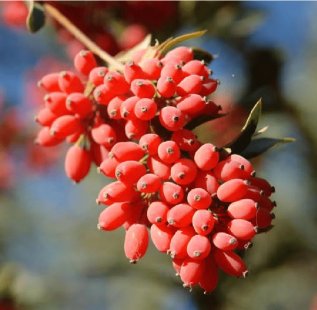
Barberry is a native plant of Iran which is found in other countries too. The barberry trees that exist in Iran are all of the same, the difference between water, air and soil in each region has an impact on the type of barberry, the properties and appearance of that barberry.
Types of barberry and its offer
due to the climatic conditions of our country, two types of barberry are produced in black and red. Barberry is used in a lot of foods and drinks, the most famous of which is barberry rice with chicken.
Blackberry:
The properties of red barberry and black barberry are somewhat similar, but because of the growth of black barberry in the mountainous environment, this barberry has more properties and is of course more expensive than red barberry. The reason for the superiority of blackberry from red barberry is because of the higher amount of a substance called barbarian. Berberine is a type of alkaloid salt that has many properties for our bodies, such as lowering blood sugar, lowering cholesterol and heart health, and of course, except for a lot of properties that it has, and these two factors have caused it to have a higher price than redbarberry.
RedBarberry:
We see three models of red barberry on the market, called "barberry mountain, puffy barberry and barberry pomegranateseeds."
In many parts of Iran, including Khorasan, barberry is produced and marketed, but because of the methods of keeping and drying this valuable product, they have different names and their appearance is a little different.
BarberryPuffs:
Puffy barberry is a good looking barberry, farmers in the early autumn when the air gets cool, the farmers cut barberry with branches from the tree or keep the same branch in the dark and cool warehouses, this maintenance takes a little time and it takes a few months for the barberry to dry completely, then the branches, wood and stones are separated from them to get ready to consume and enter the market. Puffy Barberry because of its long drying time and beautiful appearance, has a lot of high quality and demands. Exporting this Iranian barberry to global markets is booming.
This type of product is marketed about three to six months after the first harvest of barberry from the tree and the reason is the timeliness of the production process.
In the production of this type, barberry is separated from the tree with branches and the barberry seeds are not separated from the branches. Then the branches are taken to closed halls where they are hung like raisins or stacked as largely as possible.
The space of the halls should be wide so that air and humidity traffic is easily possible between the seeds of the crop and the branches. These barberry seeds stay on the branches until drying.
This same grain-to-branch bind makes it take between 2 and 6 months and even longer to dry. During this time, barberry is away from the sun and high temperatures, This prevents the seeds from losing their bright color and staying bright red.
After the time of separation of barberry from the other branches , the seeds are dried and ready for processing. Generally, in this separation, the load is filled with thorns, leaves and fine branches, and like the type of pomegranate seeds, it still needs to be blown.
After the first blowinding and separating the branches, thorns and leaves from the product, it is time to sort, which is exactly the same process and as before so that the product is ready for market.
To supply the product, it should be noted that the proper packaging of barberry should be used in bulk to prevent pesticides and decay of barberry. Often the packaging is suitable for laminated cartons.
Barberry Pomegranate Seeds:
Barberry pomegranate seeds are picked like puffy barberry in early autumn, but these barberry, unlike puffy barberry, don't separate with branches and pick them from the cluster, which is why these barberries dry faster. Usually farmers separate barberry seeds from clusters and place barberry against the sun, to dry out completely. After drying, using the natural or artificial wind blowing method, the small pieces of clusters are separated from the barberry. After this step, the barberry will be poured into the sorting machine, which can separate thorns, stones and sand from barberry to make the product ready for use.
This type is produced at the beginning of the harvest season, i.e. October, so that farmers separate the barberry seeds from the branches and spread them on large surfaces. This type of drying is carried out concurrently with harvesting and often, except for separating large branches from the load until after drying the leaves and thorns of barberry are not separated from it.
Every once in a while, the farmer moves the barberry that is placed in the open atmosphere and in the vicinity of the sunlight and the sun's heat. This way prevents the decay and accumulation of the product on eachother.
After complete drying, barberries are inflated as much as possible, meaning that by wind or in natural space or artificial wind, leaves are separated from the seeds of the original crop. After that, barberry is stored in cartons without plastic or laminate until the next processing in a cool place away from the sun.
At the next processing time, these barberries are poured into the sorting machine and leaves, branches and thorns are removed from it, then with other processes, the sorting of stone and heavy waste will be separated from it.
This product is ready to be marketed at this stage after sorting.
Barberry:
Since this type of barberry grows and proliferates as a car in the mountains, the amount of production depends on the weather of the year. picking this barberry is like other barberry in the early autumn.






User comments